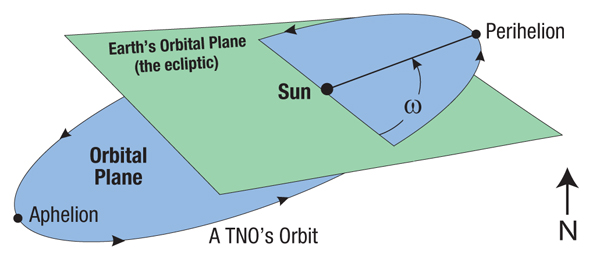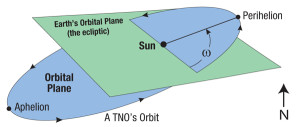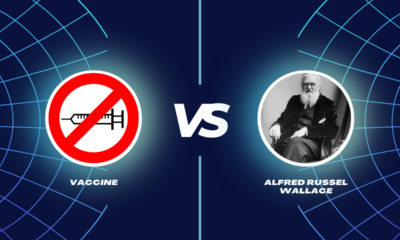Creation Corner
Trans-Neptunian objects: from earth?

Trans-Neptunian objects may have formed from water, rock and mud ejected into space at the beginning of the Global Flood on earth, a creation scientist announced yesterday.
Walter T. Brown, of the Center for Scientific Creation in Phoenix, Ariz., contacted the Creationism Examiner yesterday (May 3) to inform him of his new hypothesis. He had begun to suspect an earthly origin for trans-Neptunian objects years ago. But he hesitated to declare this on account of the implications for the likely mass of the earth before the Global Flood broke out.
“I cringed even to consider an earthly origin for trans-Neptunian objects,” he said. “Even now I hesitate, because it means the subcrustal ocean, that broke open at the Mid-Oceanic Ridge, was even deeper than I thought. I had guessed it was ten miles deep to the ground. Now I must consider that it was deeper still.”
Brown refers here to his Hydroplate Theory. According to it, the earth once had a subcrustal ocean, ten miles below ground and three quarters of a mile deep. The crust ruptured, and the subcrustal water, under pressure and critically hot, rushed out. This caused the Flood, and the seam where the breakout occurred persists as the Mid-Oceanic Ridge system on the ocean floor.
A common orbital element
What finally convinced Brown to speak, he said, was the recent discovery of dwarf planet 2012-VP113, the letter announcing this in the March 27, 2014 issue of the journal Nature, and the editorial by Megan Schwamb in the same issue. Dr. Schwamb noted that twelve large trans-Neptunian objects all shared a key orbital element: the argument of perihelion. As the illustration shows, this is the angle between the ascending node (where the object passes the plane of the ecliptic) and the point of closest approach (perihelion). Twelve large objects having that same orbital element cannot be coincidental, Brown said. It argues against these objects forming at random in any “accretion disk,” as the Nebula Theory states. Brown pointed out one more remarkable thing that Schwamb noticed: these twelve objects are all the most distant from earth of all the trans-Neptunian objects now known.
The two objects [Sedna and 2012 VP113] have similar values for one of their orbital parameters: the angle [ω] between the point of perihelion and where the orbit crosses the plane of the Solar System [from south to north],” writes Schwamb. “Interestingly, the most distant trans-Neptunian objects, with semimajor axes greater than 150 AU and perihelia beyond Neptune, also seem to have values for such angles comparable to those of Sedna and 2012 VP113. Such clustering of orbital angles seems to be unexplainable by the gravitational influence of Neptune alone. This result may be the first hint we have of an identifiable signature of the … formation mechanism [for these objects]. If true, any formation mechanism proposed for the origin of Sedna and 2012 VP113 [and the other ten most distant trans-Neptunian objects”] will need to explain this orbital structure.
Properties of trans-Neptunian objects
Brown, in addition, notes three properties that trans-Neptunian objects share in common with asteroids. They tend to be reddish in color. Many have moons, a thing conventional astronomy cannot yet explain (and which no conventional astronomer expected). They also have low densities, as asteroids do.
More remarkable still, says Brown, are the resonant objects in the Kuiper Belt, the nearest region for trans-Neptunian objects. Some of these objects have 1:2 orbital resonances with Neptune. Others (including Pluto) have 2:3 resonances.
Last of all, says Brown: most trans-Neptunian objects are more massive and more voluminous than almost all asteroids. To grow to such a size, an object must capture millions of rocks to add to its mass. The capture of rocks, either to fall on the main object or to orbit it as moons, can happen only when the object and the surrounding rocks are traveling together.
Brown emphasized that his hypothesis is only tentative. “I still have a number of observational and calculational tests to make on these objects,” he said. “If those tests are successful, and I expect them to be, then I shall have to revise other elements of the Hydroplate Theory. If not, I will discard this hypothesis, though I will then have to come up with another explanation for these facts.”
Reprinted from examiner.com
[subscribe2]
Terry A. Hurlbut has been a student of politics, philosophy, and science for more than 35 years. He is a graduate of Yale College and has served as a physician-level laboratory administrator in a 250-bed community hospital. He also is a serious student of the Bible, is conversant in its two primary original languages, and has followed the creation-science movement closely since 1993.
-

 Executive4 days ago
Executive4 days agoSecret Service chief gets no solace
-

 Executive3 days ago
Executive3 days agoWaste of the Day: Louisville Taxpayers Pay Nearly $600,000 For Empty Building’s Maintenance, Security
-

 Guest Columns4 days ago
Guest Columns4 days agoFear Itself: Democrats’ Favorite Strategy Caused Their Current Chaos
-

 Executive3 days ago
Executive3 days agoWhere is Joe Biden – or Jill?
-

 Executive1 day ago
Executive1 day agoWaste of the Day: Throwback Thursday: Cities Used Crime Prevention Funds on Soccer Games, Paper Shredding
-

 Civilization4 days ago
Civilization4 days agoBuild Iron Dome in the United States To Prepare for Israel’s Worst Day
-

 Executive2 days ago
Executive2 days agoFacile and politically motivated suggestions
-

 Executive4 days ago
Executive4 days agoThe Emerging GOP Plan To Beat Kamala Harris
















[…] from examiner.com and from Conservative News and […]
[…] Trans-Neptunian objects: from earth? […]